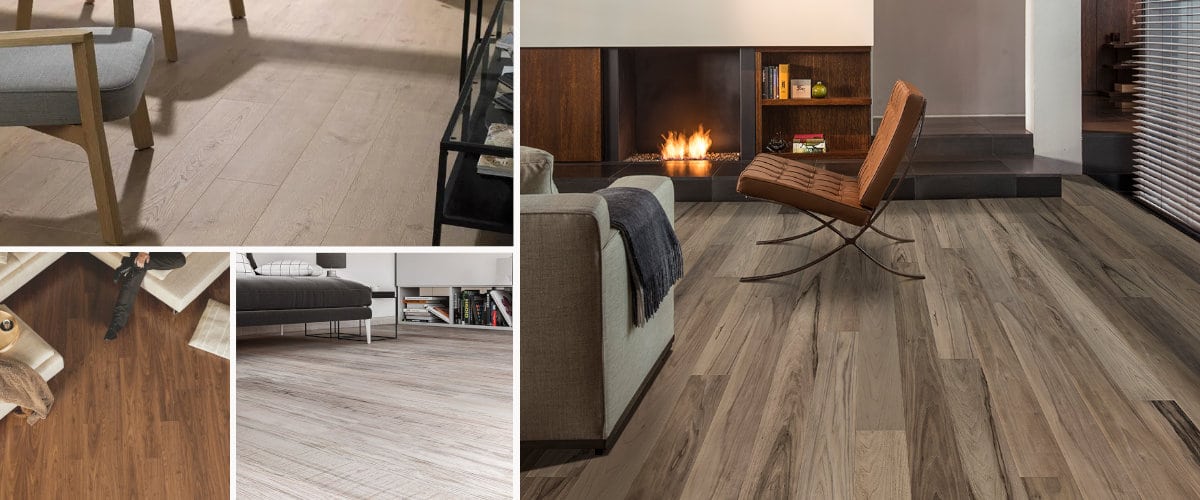
Laminate floors They are an excellent option to transform current homes. They can also be placed in all rooms, thus providing uniformity to the whole and helping the rooms appear more spacious. But how to put laminate flooring between rooms?
The advantages of betting on laminate floors are many, but one of the most important is its easy installation. To install them, it is not necessary to remove the old flooring if it is level and simply click the boards together. It seems simple and it is as you will have time to discover in this article.
One floor throughout the house
For many years the common practice in homes has been to place different floors in kitchen and bathrooms, rooms that required floors more resistant to moisture than the wood that is normally used in the rest of the house. Today, however, both laminate floors and moisture-resistant vinyl flooring have made place the same floor throughout the house be functional.

But it is not only functional, it is also an attractive alternative from an aesthetic point of view. Especially, in small houses in which the square meters do not exceed and it is chosen to open spaces, since the same floor contributes to expand them. But is this the only reason to unify them? Not at all!
- Placing the same floor unifies the design scheme of the house. An especially attractive feature in homes where living room and kitchen or bedroom and bathroom share space since contribute to harmony thereof.
- By giving uniformity to the floor and not forming the changes in the door steps, in addition, the rooms seem more spacious.
- Trip hazards disappear that could originate the level changes derived from the pavement changes.
- We get a much more atmosphere modern and minimalist.
Advantages of laminate flooring?
We have talked at length about the advantages of laminate flooring, a floor that is manufactured in layers based on a high-density fiber panel glued and compacted in a waterproof way, if we are not going to repeat ourselves. We review only the most important ones, and if you are interested you can read more advantages and disadvantages in our previous article.

- Wear protection: Its multi-layer finish provides a level of wear resistance that exceeds the normal requirements of commercial environments.
- Hypoallergenic and antibacterial: Bacteria need food and moisture to thrive, and the hermetically sealed, easy-to-clean surface of quality laminate floors prevents this. This provides a high level of hygiene naturally, without chemical antiseptics. They are, therefore, an interesting alternative for those who have a pet.
- Ease of cleaning: The hermetically sealed surface prevents dirt build-up and a top layer of resin makes cleaning easy. A vacuum cleaner and mop are sufficient for daily maintenance. And periodically a mop with little water and non-abrasive products.
- Easy installation: Installation is quick and easy, snapping the boards into place. To install them it is not necessary to remove the old flooring; It can be installed on concrete, granite, vinyl, wood, etc. as long as it is dry and level.
- Wide variety of features and qualities. There are enough varieties to say that it is customizable. We can find them with different surface resistance in order to adapt it to use, with greater or lesser resistance to humidity depending on the destination of the installation, in different slat sizes, etc.
How to lay laminate flooring?
Laminate floors can be laid over other floors but you will have to make sure that the surface is level and homogeneous. The main disadvantage of this type of flooring is its weakness in the joints and achieving a homogeneous surface is key so that they do not open or arch and expose the interior material that is less resistant. Is the surface not level? Fix specific unevenness with mortar and spread a self-leveling paste if they are more complex.

It also turns out it is essential that the surface is dry; if there are dampness, it is advisable to first solve the source of the same. You don't want to put a new floor over another in bad condition that will end up damaging the first one in the near future, right?
Click system
Once the surface is prepared, how to lay the laminate flooring is the next question. Laminate floor boards are very thin, between 7 and 12 mm thick and its installation is floating, generally, with a 'click' system. This click we are talking about can be:
- Angular click: the slats are joined by lifting the piece at an angle of 45 ° and fitting the tongue into the groove. After fitting it, you have to lower the piece until you hear the click.
- Easy click: the slats rest on the ground, without lifting the pieces. Once the tongue is inserted into the slot, you just have to push the piece to join it to the next.
Laminate floors with an “easy click” system save installation time and labor. To install them you will only have to roll out insulation roll throughout the room, leaving about 10 cm protruding from the base of the walls, and place wedges next to the walls, to solve possible expansions.

Once done, start by placing the first board at one end of the room with the tongue next to the wall. Complete the first line to the other side of the room fitting pieces together through the side assembly and then the next row begins. Present all the slats on the floor, fit the sides and push them with the tabs towards the slots of the previous row until you hear the click.
This way you will have to complete the necessary rows to complete the room, filling in the gaps next to the wall with smaller boards that you will have to cut to size with a handsaw or jigsaw.
Now that you know how to lay laminate flooring, would you dare to do it yourself?